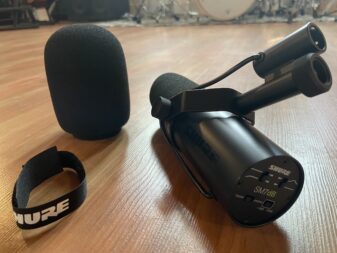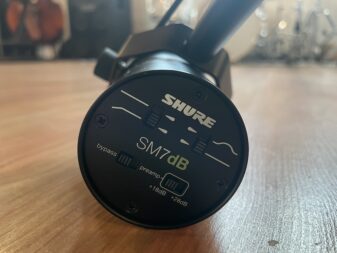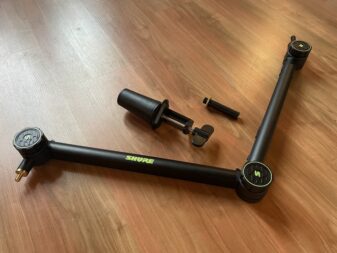
Today I have the opportunity to review two complimentary products from Shure. I begin with a look at the Shure SM7dB, an update to the legendary dynamic vocal microphone. Secondly, I review the SH-BROADCAST1 boom mic stand. Together, these two items offer a complete microphone setup for your podcasting, livestreaming, or audio narration needs. In this review, I take a closer look at the features of each item and also give you my opinion of their overall quality.
SM7dB microphone history

The bulk of this review focuses on the SM7dB dynamic microphone. The SM7dB name may sound familiar, and there is a good reason for this. Shure’s SM7dB is very closely related to the classic SM7B dynamic microphone, a widely-known microphone for music recording and broadcast purposes. With the advent of podcasting, live streaming and audio narration, some limitations of the classic SM7B were revealed. Enter the SM7dB, a very timely update for this legendary dynamic microphone that addresses those issues and adds even more features.
SM7dB microphone features
Before diving into the details of my SM7dB review, here is a short list of features and contents you will find when you make your purchase.
- Shure SM7dB cardioid dynamic microphone (with built-in Active Preamp)
- Two windscreens (standard, and close-talk)
- 5/8″ to 3/8″ thread adapter
- Velcro strap for attaching microphone cables
SM7dB has a durable build
A main reason to have confidence in the SM7dB dynamic vocal microphone is the overall build quality of the unit. Its heavy-duty metal housing is strong, creating a very durable microphone that should last for a very long time under normal conditions of use. The yoke mount on the SM7dB affords a great range of adjustment and placement of the mic according to your needs. The mount is manufactured solidly and is easy to manipulate.
Built-in tech that makes the SM7dB sound great
Yes, the SM7dB has a preamp!

Pardon my excitable tone, but the SM7dB offers a huge update over the classic SM7B model through the addition of an active preamp. One drawback of the SM7B model is the need to add a lot of gain to obtain a healthy recording signal. This would have been no problem during the golden era of studio recording, as preamps were abundantly available. Over time, home studios and project studios increased in number, often having a smaller array of preamps available. The solution (until now) was to buy a preamp to provide the necessary gain structure for recording. Eventually, one of the most popular preamps for use with the classic Shure mic became the Cloudlifter from Cloud Microphones.
The Shure developers certainly noticed the Cloudlifter trend. The result is that the SM7dB integrates the Cloudlifter into the microphone housing. This upgrade provides a simple and very welcome solution to a long-standing obstacle.
The Cloud preamp needs +48V phantom power, however. It offers between 18dB or 28dB of gain, which is ample to supplement your audio interface’s preamps and thus a complete signal strength for recording. The use of the Cloud active preamp is optional and is turned off via the small switch at the base of the microphone. In essence, the mic would then function similarly to the classic SM7B model.
EQ curves optimize your production quality
The SM7dB features two optional EQ curves. Each is activated with the flick of a switch at the base of the microphone. The first option is a High Pass filter (or Low Cut, depending on your point of view). This can be useful for low or boomy voices because the filter cuts those frequencies that can be problematic during production or broadcast. The second filter is a midrange boost, which can help to make a voice more present and cut through a mix if needed.
Magnetic shielding and air suspension
The SM7dB also features superior magnetic shielding. This shielding protects the microphone from picking up any “hum” noise that can be caused by a computer, electrical wiring, or other outside interference. While this is not a new feature, it is great that it continues to be a part of the legacy of this dynamic vocal microphone.
The same can be said for the air suspension feature. Essentially a built-in shock mount for the microphone, this feature helps to eliminate mechanical noise and other small noises that can occur during use.
The magnetic shielding and air suspension combined allow for an easy, great-sounding experience from the first use.
Swap-able pop filters
The SM7dB includes two different pop filters. The first is a standard that could be used for standard purposes such as podcasting and live streaming. The second pop filter is thicker overall and could be a good choice for audio narration. The filters are easy enough to swap for your various needs.
Cardioid polar pickup pattern
The SM7dB uses a classic cardioid polar pickup pattern. Faithful to the legendary SM7B model, this configuration is quite forgiving for speech use. Our heads can move around quite a bit, especially during animated segments of conversation or narration. On many microphones, the listener would perceive these movements, but this pickup pattern on the SM7dB helps to reduce that.
Shure and Gator SH-BROADCAST1 mic stand

The SH-BROADCAST1 boom microphone stand is an articulating arm for your microphone that features three individual elbows. It has a very professional look and feel and is aimed clearly at podcasters, live streamers, and YouTubers. The stand is manufactured by Gator Cases and is sold under the Shure brand as an officially licensed product.
The SH-BROADCAST1 comes across as quite big and bulky at first. I quickly overcome this feeling, however, as the stand does exactly everything I want it to do. The articulating arm attaches easily to my desk. I am able to manoeuvre the stand to the position I need. The result is an extremely natural feel, so much so that I can picture myself making videos and other recordings with a relaxed and comfortable feeling. There is a space in the articulating arm to hide the XLR microphone cable as well. This is a nice touch that adds a professional look when on camera.
The boom length of the SH-BROADCAST1 measures approximately one meter (3 feet) when fully extended. This fits nicely with my setup, which uses a table (think a small kitchen table) as a desk. For most professional uses, this mic stand will be a perfect length. If you are working from a home setup, it may turn out to be a bit too big. Perhaps not a big concern, but a point of note.
The mic’s articulating arm is well-built. Each elbow has a knob to tighten the positioning. Once you have your general position established, it is still possible to make smaller adjustments without manipulating knobs. The elbows move gracefully and maintain resistance enough to place the microphone exactly where you need it. Because the stand is on a swivel, it swings elegantly out of your way when not in use. I immediately see the benefit of this as I work on my productions, video editing, and other processes.
Overall, it is pleasantly surprising to discover the value the SH-BROADCAST1 mic stand adds to my setup.
The SM7dB is a timely update to a classic microphone
I strongly recommend the SM7dB dynamic vocal microphone for your podcasting, live streaming, and audio narration projects. The addition of the active preamp from Cloud Microphones makes the SM7dB an unquestionably solid investment. And, with extra features which include EQ presets, magnetic shielding, and air suspension you have everything you need for reliable vocal production quality. Adding the SH-BROADCAST1 boom microphone stand to your setup only enhances the end result.
Will you use the SM7dB for podcasting, live streaming, or audio narration? Perhaps the answer is “all of the above!”
The SM7dB dynamic vocal microphone and the SH-BROADCAST1 mic stand are available now at Best Buy Canada.




